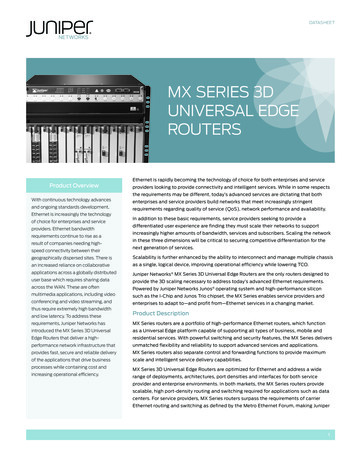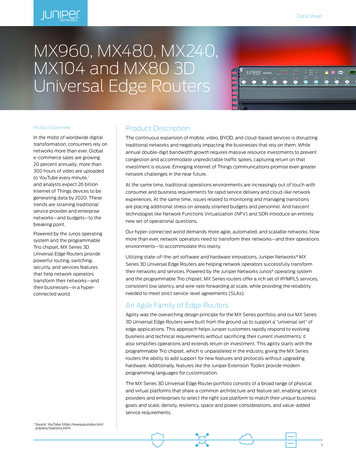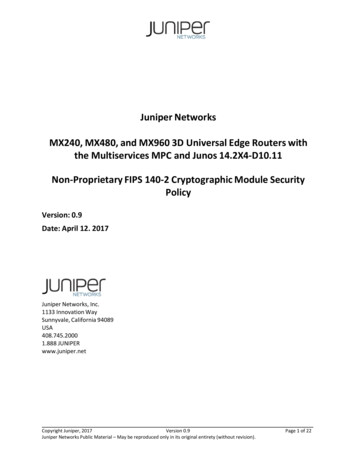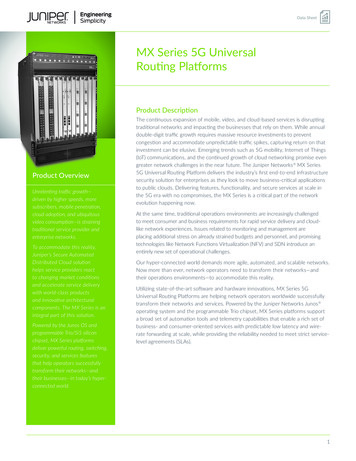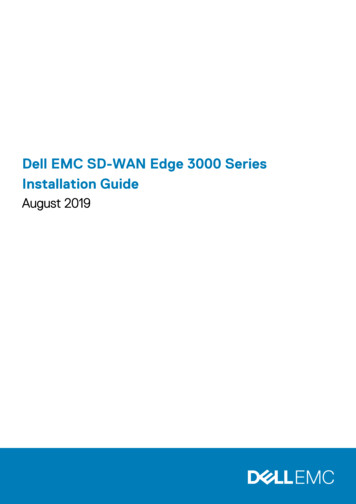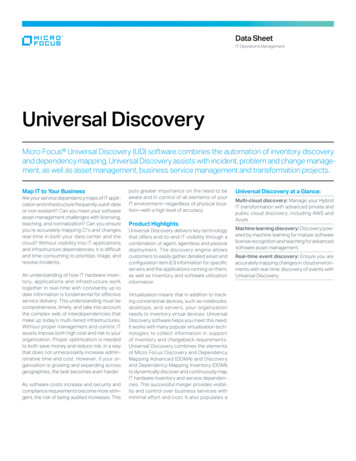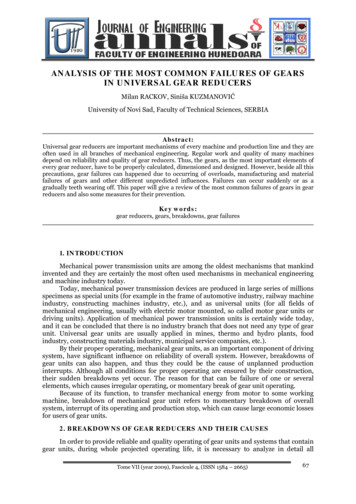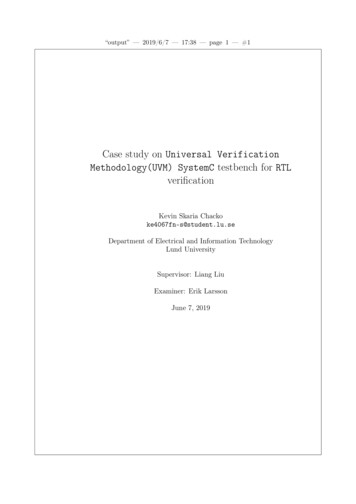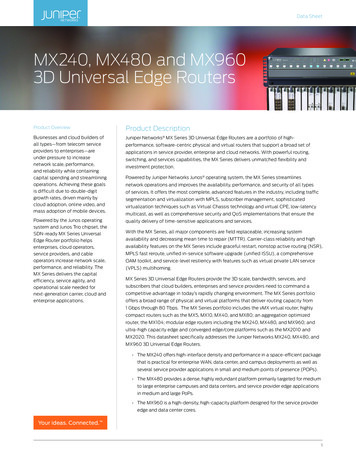
Transcription
Data SheetMX240, MX480 and MX9603D Universal Edge RoutersProduct OverviewProduct DescriptionBusinesses and cloud builders ofJuniper Networks MX Series 3D Universal Edge Routers are a portfolio of high-all types—from telecom serviceperformance, software-centric physical and virtual routers that support a broad set ofproviders to enterprises—areapplications in service provider, enterprise and cloud networks. With powerful routing,under pressure to increaseswitching, and services capabilities, the MX Series delivers unmatched flexibility andnetwork scale, performance,and reliability while containinginvestment protection.capital spending and streamliningPowered by Juniper Networks Junos operating system, the MX Series streamlinesoperations. Achieving these goalsnetwork operations and improves the availability, performance, and security of all typesis difficult due to double-digitof services. It offers the most complete, advanced features in the industry, including trafficgrowth rates, driven mainly bysegmentation and virtualization with MPLS, subscriber management, sophisticatedcloud adoption, online video, andvirtualization techniques such as Virtual Chassis technology and virtual CPE, low-latencymass adoption of mobile devices.Powered by the Junos operatingsystem and Junos Trio chipset, themulticast, as well as comprehensive security and QoS implementations that ensure thequality delivery of time-sensitive applications and services.SDN-ready MX Series UniversalWith the MX Series, all major components are field replaceable, increasing systemEdge Router portfolio helpsavailability and decreasing mean time to repair (MTTR). Carrier-class reliability and highenterprises, cloud operators,availability features on the MX Series include graceful restart, nonstop active routing (NSR),service providers, and cableMPLS fast reroute, unified in-service software upgrade (unified ISSU), a comprehensiveoperators increase network scale,OAM toolkit, and service-level resiliency with features such as virtual private LAN serviceperformance, and reliability. The(VPLS) multihoming.MX Series delivers the capitalefficiency, service agility, andMX Series 3D Universal Edge Routers provide the 3D scale, bandwidth, services, andoperational scale needed forsubscribers that cloud builders, enterprises and service providers need to command anext-generation carrier, cloud andcompetitive advantage in today’s rapidly changing environment. The MX Series portfolioenterprise applications.offers a broad range of physical and virtual platforms that deliver routing capacity from1 Gbps through 80 Tbps. The MX Series portfolio includes the vMX virtual router; highlycompact routers such as the MX5, MX10, MX40, and MX80; an aggregation optimizedrouter, the MX104; modular edge routers including the MX240, MX480, and MX960; andultra-high capacity edge and converged edge/core platforms such as the MX2010 andMX2020. This datasheet specifically addresses the Juniper Networks MX240, MX480, andMX960 3D Universal Edge Routers. The MX240 offers high-interface density and performance in a space-efficient packagethat is practical for enterprise WAN, data center, and campus deployments as well asseveral service provider applications in small and medium points of presence (POPs). The MX480 provides a dense, highly redundant platform primarily targeted for mediumto large enterprise campuses and data centers, and service provider edge applicationsin medium and large PoPs. The MX960 is a high-density, high-capacity platform designed for the service provideredge and data center cores.Your ideas. Connected. 1
MX Series 3D Universal Edge RoutersData SheetArchitecture and Key ComponentsModular Port Concentrator (MPC)Table 1: MX Series Key ComponentsMPCs leverage the Junos Trio chipset to deliver high density 1, 10,DescriptionMX240MX480MX960System capacity11.92 Tbps5.12 Tbps9.92 TbpsSwitch fabriccapacity per slot2480 Gbps480 Gbps480 GbpsMPCs and DPCs perchassis3612Chassis per rack96340 and 100 Gigabit Ethernet, as well as ATM/SONET and inlineservices across the entire MX Series portfolio. These advancedcapabilities allow you to flexibly mix and match interfaces tocreate service-specific and “pay-as-you-grow” configurations.The MPC houses the PFEs to deliver comprehensive Layer3 routing (IPv4 and IPv6), MPLS, and Layer 2 switching andadvanced Hierarchical quality-of-service (HQoS).For more details on MPCs, please visit www.juniper.net/us/en/Switch Control Board (SCB)local/pdf/datasheets/1000294-en.pdf.The SCB powers on and powers off cards, controls clocking,Dense Port Concentrator (DPC)resets, boots, monitors and controls system functions, includingfan speed, board power status, inline power distribution module(PDM) status and control, and the system front panel. Theswitch fabric is integrated into the SCB, providing a non-blockingarchitecture that connects to all within the chassis, and theRouting Engine installs directly into the SCB. Three SCBs areavailable for the MX960, MX480, and MX240 routers—the SCB,the SCBE, and the SCBE2.DPCs provide multiple physical interfaces and PFEs on a singleboard that installs in a slot in the MX Series routers. A DPCreceives incoming packets from the network and sends outgoingpackets to the network. The PFEs on a DPC are equippedwith purpose-built ASICs that perform packet processingand forwarding. Each PFE consists of one I-Chip for Layer 3processing and one Layer 2 network processor.For more details on the DPC, please visit www.juniper.net/us/en/Table 2: SCB lNumberDescriptionSwitch Fabric Capacity (Tbps)SCBE2MX-BBEnhancedMX SwitchControl Board(SCBE2)1.92SCBEMX-BBEnhancedSwitch ControlBoard (SCBE).962.725.12SCBMX960BBSwitch ControlBoard (SCB).481.442.64MX240MX4805.12MX9609.92Junos OSJunos OS is a single, modular OS with a single release cycle thatis supported across all Juniper Networks routers, switches, andsecurity devices in a unique approach that extends significantoperational and economic benefits. Junos OS streamlinesnetwork operations and improves the availability, performance,and security of all types of services supported by the MXRouting Engine (RE)The Routing Engine handles all routing protocol processes,the software processes that control the router’s interfaces, thechassis components, system management, and user accessto the router. These routing and software processes run on topof a kernel that interacts with the Packet Forwarding Engine(PFE). The Routing Engine also provides control plane functionsand runs Junos OS. Software processes that run on the RoutingEngine maintain the routing tables, manage the routing protocolsused on the router, control the router interfaces, control somechassis components, and provide the interface for systemmanagement and user access to the router. Routing Enginescommunicate with DPCs and MPCs via dedicated out-of-bandSeries 3D Universal Edge Routers, including L2/L3 VPNs, trafficsegmentation, low-latency multicast, and comprehensiveQoS features that accelerate the delivery of time-sensitiveapplications.Junos OS also offers advanced virtualized network services suchas Virtual Chassis technology, cloud-based CPE, and networkedge services such as network address translation (NAT) andcarrier-grade NAT (CGNAT), IPsec, flow monitoring, and statefulfirewall—allowing the seamless and operationally efficientintegration of these advanced service capabilities directly onthe MX Series. Unlike other network operating systems that arefragmented into many different release images joined under acommon “brand,” our unified approach to OS development anddeployment reduces the cost, complexity, and time to implementand maintain network infrastructure.management channels, providing a clear distinction between thecontrol and forwarding planes.2
MX Series 3D Universal Edge RoutersData SheetMX Series Features and BenefitsComprehensive Broadband Edge CapabilitiesUnmatched Network AvailabilityThe MX Series provides a powerful broadband network gatewayThe MX Series 3D is a true carrier-grade platform that ensuresnonstop network availability with layered physical, logical, andprotocol-level resiliency options. Chassis redundancy is based onadvanced Virtual Chassis technology. Link aggregation group (LAG)technology supports stateful card and port redundancy, as well assubscriber and session persistence in the case of switchover.(BNG) that lets operators provision broadband services for todayand tomorrow with support for Point-to-Point Protocol (PPP)subscriber termination, Dynamic Host Configuration Protocol(DHCP), IPv4/IPv6 local server, and relay proxy for subscribers’migration to DHCP access models. Juniper’s solution alsosupports RADIUS and Diameter back-end servers to facilitateauthentication, policy control, and accounting, and it offersOn the software side, Junos OS has a modular architecture thatflexible L2/L3 wholesale models. The MX Series BNG alsoruns each program independently with its own memory spacedelivers advanced features such as hierarchical queuing, granularto ensure that processes do not interfere with one another. AQoS, and dynamic multilayer service activation.full set of high availability (HA) features, including unified inservice software upgrade (ISSU); a comprehensive OAM toolkit,Broad Business Edge CapabilitiesJunos XML management protocol commit script capabilities andThe MX Series provides a comprehensive VPN toolkit thatservice-level resiliency with features such as virtual private LANenables feature-rich, standards-based, secure interworking andservice (VPLS) multihoming.streamlined operations needed to help you reduce expenses andAdvanced Virtualized Network Servicesenable innovative business services. In addition to basic L3 VPN,L2 VPN, and VPLS, enhanced VPN service support includes QoSJunos OS-based virtualized network services enable cost-prioritized VPN traffic for voice and video, VPN-aware multicasteffective router integrated service scale without impactingand firewall services that leverage technologies such as LDP-forwarding performance or requiring operators to use third-partyBGP VPLS interworking, point-to-multipoint label-switchedappliances. The MX Series can efficiently support services thatpaths (P2MP LSPs), BGP-based multicast L3VPN, L2 VPNinclude the following:interworking to connect dissimilar L2 access networks, MPLS Junos Video Focus for proactive video quality assurance Junos Address Aware, which helps you conserve your IPv4plug-and-play, and IPsec/GRE VPNs.Metro Ethernet Capabilitiesaddress pool, ensure IPv4/IPv6 coexistence, and transitionThe MX Series is Carrier Ethernet 2.0 certified and supportsto IPv6metro Ethernet and aggregation solutions with a full suite of Junos Network Secure, which provides stateful firewallservices for network protection and managed security offers Junos VPN Site Secure, which uses standard encryptionmodes to secure communication between the customerpremises and the network edge, and for added security overL3 VPNs Junos Traffic Vision, which monitors traffic flows andgenerates detailed flow recordsrouting and switching features, allowing you to choose thedeployment model that best fits your business and technicalneeds. The MX Series can be flexibly deployed as an IP/IP VPNedge router, VPLS provider edge router (VPLS–PE), MPLS labelswitching router (LSR), L2 switch, or L3 router in mobile, fixed,and cable networks.Universal SDN Gateway CapabilitiesSupporting a wide range of SDN and encapsulation protocols, theThe Service Control Gateway, an open platform that enables theMX Series is ideal as an SDN universal gateway to bridge betweencreation and delivery of subscriber- and application-aware servicesphysical and virtual networks—even networks running differentand service chaining.encapsulation or overlay technologies. Examples of supportedprotocols include Multiprotocol BGP (MBGP), dynamic tunnelsusing MPLS-over-GRE or VXLAN encapsulation, virtual routingtables and forwarding (VRF) and EVI (E-VPNs), mechanismsto send traffic between VRF and global routing table based onconfiguration and policy, and support for NETCONF.3
MX Series 3D Universal Edge RoutersData SheetMX240MX480MX960Specifications and ApprovalsThis section lists basic specifications by platform. For further details, please refer to the hardware installation manuals X240MX480MX960Physical dimensions(W x H x D)17.5 x 8.7 x 23.8 in(44.5 x 22.1 x 60.5 cm)17.5 x 14 x 23.8 in(44.5 x 35.6 x 60.5 cm)17.5 x 27.8 x 23.5 in(44.5 x 70.5 (16 RU) x 59.7 cm)Weight (lb/kg) fully configured130 lb/59 kg180 lb/81.7 kg334 lb/151.6 kgMountingFront or centerFront or centerFront or centerPower (DC/AC)-40 to -72 V DC100 to 240 V AC-40 to -72 V DC100 to 240 V AC-40 to -72 V DC200 to 240 V ACDimensions and PowerJuniper Networks Services and SupportJuniper Networks is the leader in performance-enabling services that are designed to accelerate, extend, and optimize your highperformance network. Our services allow you to maximize operational efficiency while reducing costs and minimizing risk, achieving afaster time to value for your network. Juniper Networks ensures operational excellence by optimizing the network to maintain requiredlevels of performance, reliability, and availability. For more details, please visit www.juniper.net/us/en/products-services.4
MX Series 3D Universal Edge RoutersData SheetOrdering InformationModel NumberDescriptionBase UnitMX240MX480MX960DC ChassisMX240BASE-DC, MX240BASE3-DCMX480BASE-DC, MX480BASE3DCMX960BASE3-DC; MX960BASEDCAC ChassisMX240BASE-AC, MX240BASE3ACH, MX240BASE3-ACLMX480BASE-AC, MX480BASE3-ACMX960BASE3-AC; MX960BASE-ACMPCMX-MPC1-3DMPC1 with port queuing; includes full scale L2/L2.5 and reduced scale L3 featuresMX-MPC1-3D-QMPC1 with per-IFL HQoS, 128,000 queues (maximum 64000 egress); includes full scale L2/L2.5 and reducedscale L3 featuresMX-MPC1-3D-Q-R-BMX
router, the MX104; modular edge routers including the MX240, MX480, and MX960; and ultra-high capacity edge and converged edge/core platforms such as the MX2010 and
